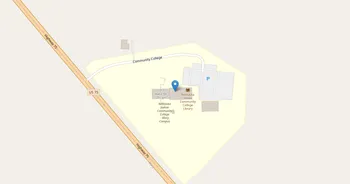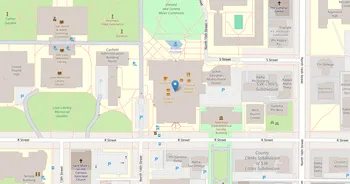University of Nebraska (UNO), at Omaha : Overview, Courses, Scholarships & Rankings
About University of Nebraska
Set in a Midwestern city with big-company clout and neighborhood charm, the University of Nebraska at Omaha blends practical academics with a strong service mindset. Students find strengths in business, public affairs, computing and STEM, alongside vibrant arts and education. Classrooms and labs are modern, with support that runs deep through advising, tutoring, counseling, and career coaching.
Campus life feels grounded and welcoming, with commuters and residents mixing through clubs, service projects, and plenty of outdoor and fitness options. Hockey nights draw a crowd, and campus festivals keep the calendar busy. Career prep leans on the city's network of corporations, startups, and nonprofits, so internships become part of the rhythm. The vibe is inclusive, a little scrappy in the best way, and proud of its Maverick identity.
Key Institutional Details
Contact & Profile
Academic & Institutional
Academic Programs & Fields of Study
University of Nebraska (UNO), at Omaha offers 95 degree programs across 25 major academic fields, graduating approximately 3,539 students annually. The most popular fields by graduate volume are Business (15 programs, 606 graduates), Education (11 programs, 479 graduates), Computer & IT (11 programs, 350 graduates), Liberal Arts (1 programs, 338 graduates) and Security & Safety (2 programs, 295 graduates). Explore program details, award levels, and graduate demographics below.
Business (15 programs, 606 graduates)
Business Administration, Marketing and Entrepreneurship
| Program Name | Graduates | Gender Distribution | Award Levels | CIP Code |
|---|---|---|---|---|
| Business Administration and Management | 242 |
|
Bachelor's
Master's
|
52.0201 |
| Accounting | 88 |
|
Bachelor's
Master's
|
52.0301 |
| Marketing Management | 77 |
|
Bachelor's
|
52.1401 |
| Banking and Financial Services | 48 |
|
Bachelor's
|
52.0803 |
| Finance, General | 30 |
|
Bachelor's
|
52.0801 |
| Logistics and Supply Chain Management | 26 |
|
Bachelor's
Postbac Cert.
|
52.0203 |
| Real Estate | 25 |
|
Bachelor's
Postbac Cert.
|
52.1501 |
| Small Business Management | 23 |
|
Bachelor's
|
52.0703 |
| Human Resources Management | 19 |
|
Bachelor's
|
52.1001 |
| Business Economics | 9 |
|
Bachelor's
|
52.0601 |
| International Business and Trade | 5 |
|
Bachelor's
|
52.1101 |
| Business Statistics | 5 |
|
Bachelor's
|
52.1302 |
| Investments and Securities | 4 |
|
Bachelor's
|
52.0807 |
| Human Resources Development | 4 |
|
Postbac Cert.
|
52.1005 |
| Business Administration and Management | 1 |
|
Postbac Cert.
|
52.0299 |
Education (11 programs, 479 graduates)
Educational Sciences, Teaching Methods and Pedagogy
| Program Name | Graduates | Gender Distribution | Award Levels | CIP Code |
|---|---|---|---|---|
| Elementary Education | 161 |
|
Bachelor's
Master's
|
13.1202 |
| Secondary Education and Teaching | 94 |
|
Bachelor's
Master's
|
13.1205 |
| School Counseling and Guidance | 51 |
|
Master's
|
13.1101 |
| Special Education Teaching | 44 |
|
Bachelor's
Postbac Cert.
Master's
|
13.1001 |
| Speech and Language Impairment Education | 43 |
|
Bachelor's
Master's
|
13.1012 |
| Early Childhood Special Education Teaching | 30 |
|
Bachelor's
|
13.1015 |
| Educational Leadership and Administration | 26 |
|
Master's
Post-Master's
Doctorate (R)
|
13.0401 |
| English as a Second Language (ESL) Teaching | 14 |
|
Postbac Cert.
|
13.1401 |
| Music Teacher Education | 9 |
|
Bachelor's
Postbac Cert.
|
13.1312 |
| Secondary Special Education Teaching | 5 |
|
Bachelor's
|
13.1019 |
| Reading Teacher Education | 2 |
|
Master's
|
13.1315 |
Computer & IT (11 programs, 350 graduates)
Computer Science, Information Technology and Cybersecurity
| Program Name | Graduates | Gender Distribution | Award Levels | CIP Code |
|---|---|---|---|---|
| Computer Science | 143 |
|
Bachelor's
Master's
|
11.0701 |
| Information Science | 87 |
|
Bachelor's
Postbac Cert.
Master's
|
11.0401 |
| Computer and Information Sciences, Other | 48 |
|
Bachelor's
Postbac Cert.
Master's
|
11.0199 |
| Information Systems Security and Auditing | 43 |
|
Bachelor's
Master's
|
11.1003 |
| Computer and Information Sciences | 10 |
|
Postbac Cert.
Master's
|
11.0101 |
| Information Technology | 6 |
|
Doctorate (R)
|
11.0103 |
| Informatics | 4 |
|
Master's
Doctorate (R)
|
11.0104 |
| Network and System Administration | 3 |
|
Postbac Cert.
|
11.1001 |
| Computer Systems Analysis | 2 |
|
Postbac Cert.
|
11.0501 |
| Data Modeling and Database Administration | 2 |
|
Postbac Cert.
|
11.0802 |
| IT Project Management | 2 |
|
Postbac Cert.
|
11.1005 |
Liberal Arts (1 programs, 338 graduates)
Liberal Arts Education, General Studies and Humanities
| Program Name | Graduates | Gender Distribution | Award Levels | CIP Code |
|---|---|---|---|---|
| General Studies | 338 |
|
Bachelor's
|
24.0102 |
Security & Safety (2 programs, 295 graduates)
Emergency Management, Law Enforcement and Public Safety
| Program Name | Graduates | Gender Distribution | Award Levels | CIP Code |
|---|---|---|---|---|
| Criminal Justice and Safety Studies | 254 |
|
Bachelor's
Master's
Doctorate (R)
|
43.0104 |
| Crisis and Emergency Management | 41 |
|
Certificate (≥2 yrs)
Bachelor's
|
43.0302 |
Psychology (4 programs, 218 graduates)
Psychological Sciences, Mental Health and Behavioral Studies
| Program Name | Graduates | Gender Distribution | Award Levels | CIP Code |
|---|---|---|---|---|
| General Psychology | 192 |
|
Bachelor's
Master's
Doctorate (R)
|
42.0101 |
| School Psychology | 18 |
|
Master's
Post-Master's
|
42.2805 |
| Industrial-Organizational Psychology | 4 |
|
Master's
|
42.2804 |
| Applied Behavior Analysis | 4 |
|
Postbac Cert.
Master's
|
42.2814 |
Public Services (3 programs, 198 graduates)
Public Administration, Social Work and Community Services
| Program Name | Graduates | Gender Distribution | Award Levels | CIP Code |
|---|---|---|---|---|
| Social Work | 147 |
|
Bachelor's
Master's
|
44.0701 |
| Public Administration | 50 |
|
Postbac Cert.
Master's
Doctorate (R)
|
44.0401 |
| Social Work | 1 |
|
Postbac Cert.
|
44.0799 |
Biological Sciences (5 programs, 180 graduates)
Life Sciences, Biotechnology and Biomedical Research
| Program Name | Graduates | Gender Distribution | Award Levels | CIP Code |
|---|---|---|---|---|
| Biology and Biological Sciences | 96 |
|
Bachelor's
Master's
|
26.0101 |
| Neuroscience | 33 |
|
Bachelor's
|
26.1501 |
| Biomechanics | 26 |
|
Bachelor's
Master's
Doctorate (R)
|
26.0913 |
| Biotechnology | 22 |
|
Bachelor's
|
26.1201 |
| Bioinformatics | 3 |
|
Bachelor's
|
26.1103 |
Social Sciences (8 programs, 126 graduates)
Sociology, Anthropology and Political Science Studies
| Program Name | Graduates | Gender Distribution | Award Levels | CIP Code |
|---|---|---|---|---|
| Political Science and Government | 56 |
|
Bachelor's
Master's
|
45.1001 |
| Sociology | 27 |
|
Bachelor's
Postbac Cert.
Master's
|
45.1101 |
| Econometrics and Quantitative Economics | 13 |
|
Master's
|
45.0603 |
| Geography | 13 |
|
Bachelor's
Master's
|
45.0701 |
| Economics | 6 |
|
Bachelor's
|
45.0601 |
| American Government and Politics | 5 |
|
Postbac Cert.
|
45.1002 |
| International Relations and National Security | 3 |
|
Postbac Cert.
|
45.0999 |
| Urban Studies and Affairs | 3 |
|
Master's
|
45.1201 |
Interdisciplinary (5 programs, 109 graduates)
Cross-Disciplinary Studies and Integrated Research Programs
| Program Name | Graduates | Gender Distribution | Award Levels | CIP Code |
|---|---|---|---|---|
| Multi- and Interdisciplinary Studies | 30 |
|
Bachelor's
Master's
|
30.9999 |
| Gerontology | 28 |
|
Bachelor's
Postbac Cert.
Master's
Doctorate (R)
|
30.1101 |
| Mathematics and Computer Science | 25 |
|
Master's
|
30.0801 |
| Global Studies | 18 |
|
Bachelor's
|
30.2001 |
| Natural Sciences | 8 |
|
Bachelor's
|
30.1801 |
Admission Requirements & Test Scores
Comprehensive overview of admission criteria, standardized test score ranges, and application requirements for prospective students at University of Nebraska (UNO), at Omaha.
Application Requirements
Data based on IPEDS for 2022-2023 academic year. Test score ranges represent the middle 50% of admitted students (25th-75th percentile). Requirements may vary by program.
Tuition, Fees & Estimated Costs
Overview of tuition rates, housing, and other annual education expenses for undergraduate and graduate students
Financial Aid & Student Support
Summary of scholarships, grants, student loans, and financial aid statistics for undergraduate students
Student Success Metrics
Graduation rates and post-graduation earnings to help assess student outcomes and long-term value of education.
Loan Burden & Repayment Outcomes
Breakdown of loan repayment rates and student debt levels by income and dependency status.
Frequently Asked Questions
Find answers to the most common questions about University of Nebraska (UNO), at Omaha
How much does it cost to attend University of Nebraska (UNO), at Omaha?
The annual tuition at University of Nebraska (UNO), at Omaha is $8,370 for in-state students and $22,358 for out-of-state students. When including room and board, books, and other expenses, the total estimated cost is approximately $24,974 for in-state students and $38,962 for out-of-state students. Additional costs include room and board $11,610 (on) / $11,998 (off) and books and supplies $1,120.
Data based on IPEDS program completions for 2022-2023 academic year. Tuition and cost estimates are approximate and may not include all fees, personal expenses, or transportation costs.
What academic programs and degree levels does University of Nebraska, at Omaha offer?
University of Nebraska (UNO), at Omaha offers 95 academic programs across 25 major fields of study, with available degree levels: Certificate (≥2 yrs), Bachelor's, Postbac Cert., Master's, Post-Master's, Doctorate (Research).
Most popular program areas include:
- Business Administration, Marketing and Entrepreneurship (15 programs)
- Educational Sciences, Teaching Methods and Pedagogy (11 programs)
- Computer Science, Information Technology and Cybersecurity (11 programs)
- Liberal Arts Education, General Studies and Humanities (1 programs)
- Emergency Management, Law Enforcement and Public Safety (2 programs)
Data based on IPEDS program completions for 2023-2024 academic year. Numbers reflect programs where students graduated, not all offered programs.
What is the acceptance rate for University of Nebraska, at Omaha?
University of Nebraska (UNO), at Omaha has an 86.9% acceptance rate and a 25.1% yield rate, making it moderately selective.
Admission statistics breakdown:
- Total applicants: 9,889
- Students admitted: 8,594
- Students enrolled: 2,156
Data based on IPEDS for 2022-2023 academic year. Admission statistics may vary by program and application cycle.
What financial aid and scholarships are available at University of Nebraska, at Omaha?
University of Nebraska (UNO), at Omaha provides financial aid to 19% of first-time, full-time students, with average grants of $7,339 and average loans of $5,865.
Average financial aid amounts by type:
- Pell grants: $5,473
- State/Local grants: $2,505
- Institutional grants: $4,112
- Federal loans: $4,821
The university supports 1,813 students with grants and 675 students with loans annually.
Data based on IPEDS for 2022-2023 academic year. Financial aid amounts and percentages may vary by program, enrollment status, and individual circumstances.
What is the average salary for University of Nebraska, at Omaha graduates?
University of Nebraska (UNO), at Omaha graduates earn a median salary of $45,494 after 6 years and $53,909 after 10 years.
The salary range 10 years after graduation spans from $37,105 (25th percentile) to $77,577 (75th percentile), with top earners reaching $79,700 (90th percentile).
Data based on IPEDS for 2022-2023 academic year. Salary data reflects graduates who received federal financial aid (approximately 60% of all graduates). Actual earnings may vary significantly based on program, location, and individual circumstances.
Related Universities




Found something useful? Help others discover it too! Share with friends, on social media, or save for later - every share helps someone find the information they need.